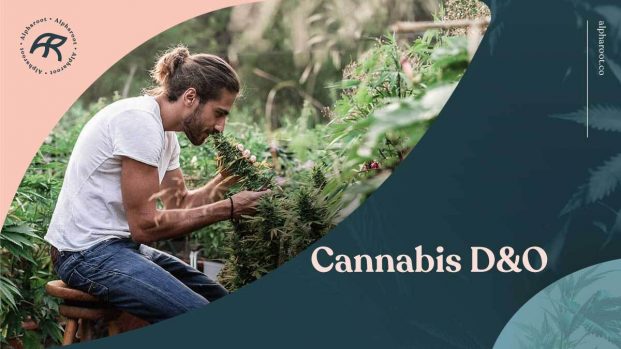The past year has been a particularly eventful one in the world, in general, not to mention in the world of directors and officers (D&O) insurance. Let’s face it; company leaders feel more sting anytime you add a rapidly evolving industry to a litigious society. Although D&O litigation has decreased in frequency over the past few years, securities suits, merger-related cases, and class action lawsuits remain ongoing threats.
This guide reviews how cannabis D&O insurance is designed to protect companies and their leaders if someone sues them. But how does this coverage typically play out? What insurance options do you have? Let’s talk about the nuts and bolts of cannabis D&O insurance and what it means for your company.
The D&O Landscape
There were 402 federal court securities suit filings in 2019. The following year, only 324 surfaced, and 2021 brought even fewer still. While these stats could signal a more forgiving environment, another message might be that we’re in the eye of a perfect storm.
Also, considering that the pandemic caused a couple of lulls in litigation during 2020, D&O lawsuits climbed, but the number of listed companies has fallen. The bottom line is that the threat for D&O litigation is still very real, with the total value of settlements in 2020 being $4.2 billion.
Many experts think securities law often plays a sort of catchall role, encompassing allegations about social media posts, environmental catastrophes, racial justice, sexual impropriety, privacy lapses, etc. No matter which side of the fence you fall, the numbers don’t lie; the D&O market has been experiencing a hardening for several years, and premiums are often a jagged pill to swallow.
However, while it’s tough to know what to make of these D&O happenings, we can depend on the coverage to remain steady. So, let’s talk about cannabis D&O insurance.
Cannabis D&O Defined
Like any other industry, cannabis companies must protect the organization and its executives from claims against them. Unfortunately, shareholders, competitors, and investors, to name a few, can sue a cannabis company’s directors and officers. These lawsuits put the company’s balance sheet at stake, along with the executive’s personal assets.
Who Cannabis D&O Protects
Cannabis D&O insurance protects the company and its executives if someone sues either or both of them. As mentioned, the allegations against directors and officers run rampant nowadays; however, most cases stem from mismanagement of the company.
Cannabis company executives frequently face steep defense costs and settlements. Unfortunately, the chance for a private or public company to encounter D&O litigation for the past few years is roughly one in twenty. Fortunately, cannabis D&O insurance can respond to cover these expenses.
Additionally, cannabis D&O insurance benefits many organizations, from cultivators to multi-state operators to brands. Nevertheless, it works best for businesses with significant or unique liabilities, such as cannabis companies that find it challenging to place adequate coverage in other lines. Remember, most venture capital-backed companies need cannabis D&O insurance to move forward with funding rounds.
Although cannabis isn’t new to you or us, many carriers approach this industry cautiously because society (and the insurance industry) still view it as “emerging.” Still, carriers are warming up to all things cannabis, so we look forward to a more competitive environment in the future.
What Cannabis D&O Covers
As mentioned, cannabis D&O can protect the company and its executives if someone files a lawsuit. But there are three layers to cannabis D&O insurance worth reviewing, including:
- Side A: Suppose directors are personally sued and forced to pay defense costs and settlements. This portion of cannabis D&O insurance kicks in to protect the individual. However, Side A will only pay the individual directors if the entity (company) can’t, such as if the company is insolvent. Many pre-going public companies purchase additional Side A coverage limits, a strategic approach to risk management.
- Side B: When the entity indemnifies individuals named in the lawsuit, Side B coverage reimburses those costs. However, it only extends to indemnifying insured individuals named in the lawsuit.
- Side C: This coverage provides a balance sheet protection for the company named in the lawsuit alongside an individual executive. Side C coverage will reimburse the costs and settlements incurred.
Cannabis D&O Insurance Options
Insurance endorsements or enhancements are also known as riders or add-ons. Despite whatever official name you run with, these options modify a commercial policy by adding, deleting, or excluding specific coverage. In short, it’s a handy way to customize a cannabis D&O policy — or other coverage, in general.
Popular Cannabis D&O Endorsements
- Additional Side A Limit: As mentioned, additional Side A coverage responds if the insured exhausts the rest of the policy.
- Dilution Claims: Sometimes, shareholders think that a funding round might have “watered down” or diluted their stake in the company.
- Bump-up Claims: This endorsement comes into play when shareholders feel dissatisfied with an acquisition offer.
- Employed Lawyers: In-house lawyers often become heavily involved in D&O litigation but aren’t typically covered by a standard D&O policy.
- Class Certification Investigation: Carriers can include a sublimit to help pay for specific class certification investigation costs.
- Roadshow Coverage: Claims sometimes arise from alleged misinterpretation during the preparation period before an IPO.
- Broad Change in Control and M&A Provisions: Cannabis companies experience transitions regularly; however, carriers can drop their coverage if they think too much change occurs.
- Pre-arranged ERP (“Tail”) Pricing: An extended reporting period (ERP) add-on lets you report claims ever after the policy expires.
Standard Cannabis D&O Exclusions
We frequently see the following cannabis D&O exclusions; however, these don’t typically cause alarm.
- Breach of Contract: Although it’s not a law, it’s known as a breach of contract when executives fail to comply with a signed contract.
- “Other” Insurance: Many workplace issues fall outside of the D&O policy’s scope and should be addressed by other policies.
- Personal Gain: Insured executives can’t cause damage to a business by gaining undeserved profit or advantage.
- Discrimination/Wrongful Termination: Employees sometimes file a D&O claim if they think the company has wronged them, despite that it’s an employment practices liability (EPL) insurance issue.
- Dishonest, Wrongful, Fraudulent Conduct: Cannabis company executives have a duty of obedience to comply with the industry’s legal standards.
- Fines, Penalties, Punitive Damages: Most D&O policies don’t cover these costs because it negates their purpose, to punish wrong behavior.
- Prior Acts: D&O insurance is typically a claims-made policy, so claims must be filed during the policy period to be covered.
- Defamation, Libel, and Slander Claims: Cannabis executives must be accountable for their words, albeit human nature highly informs the severity of these issues.
- Catastrophic Hazards: Damages from devastating events, such as war, acts of terrorism, nuclear events, and environmental damage are not typically covered losses.
“Red Flag” Cannabis D&O Exclusions
Unlike the exclusions listed above, here are a handful of D&O exclusions that you might want to double-check, mainly because they could signal inadequate coverage.
- Conduct Exclusions: Although D&O policies usually include some conduct exclusions, watch out for subtle wording as they might tremendously inform a claim’s outcome.
- Regulatory Exclusions: Rules out coverage for any claims brought by national and state banking authorities, governmental, quasi-governmental, or self-regulatory agency against company executives.
- Insured vs. Insured Exclusions: This exclusion isn’t uncommon as executives can undoubtedly sue each other. Still, read through the carvebacks thoroughly as they tend to evolve quickly in the insurance world.
- “Laser” Exclusions: Underwriters will sometimes focus on a particular risk they’re unwilling to accept. These are called “laser” exclusions, so review these carefully.
- Antitrust or Competition Exclusions: Some D&O policies exclude public securities offerings and tradings. Be mindful of these, especially before going public.
- Commissions Exclusions: A rare but old exclusion excludes coverage for claims from payments for the benefits of an agent or foreign government employee. It’s a real oddball and typically unnecessary.
- FTMI Exclusions: Another oldie is the failure to maintain insurance exclusions, which speaks for itself.
The Next Step
Navigating cannabis D&O insurance is a tall order, albeit a critical one. Here at AlphaRoot, we specialize in insurance for the cannabis industry, from seed to sale. Our team customizes insurance packages based on your unique needs to help you grow and scale.
That said, we understand the importance of having a robust risk management plan and have recently rolled out a new product to support this endeavor. Our new management liability program is exclusive to AlphaRoot clients and includes:
- Cannabis D&O Insurance
- Employment Practices Liability Insurance
- Fiduciary Liability Insurance
Protecting your cannabis company can seem confusing; however, we’re a full-service insurance brokerage working with carriers worldwide to offer you the best coverage possible. We’re here to help! Please reach out to us today by emailing [email protected] or calling 646-854-1093 for a customized letter of commitment or learning more about your cannabis insurance options.








